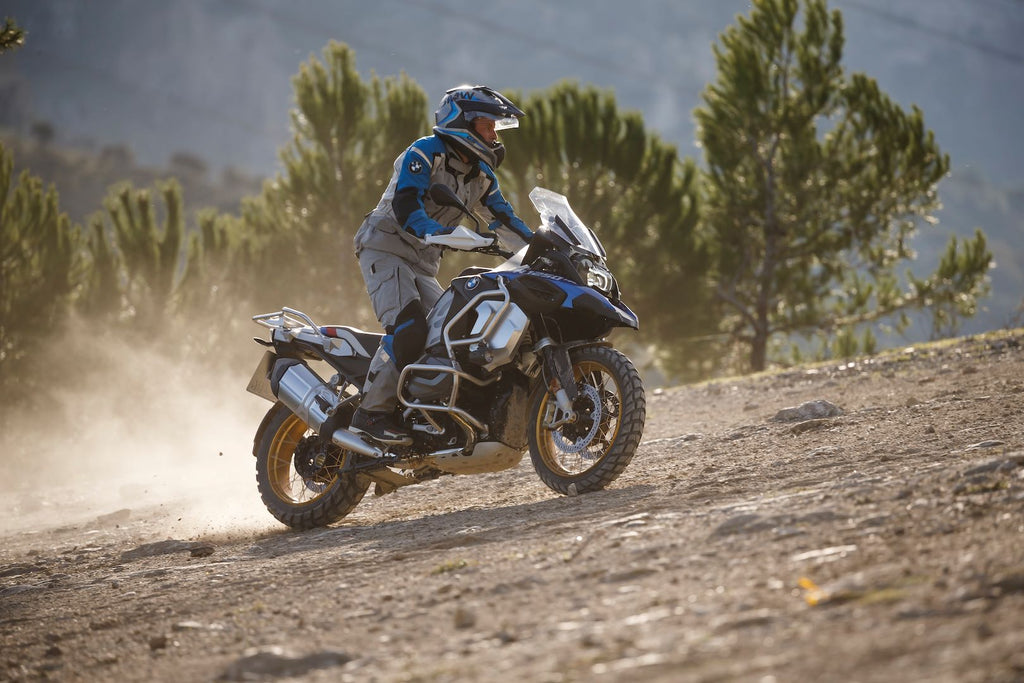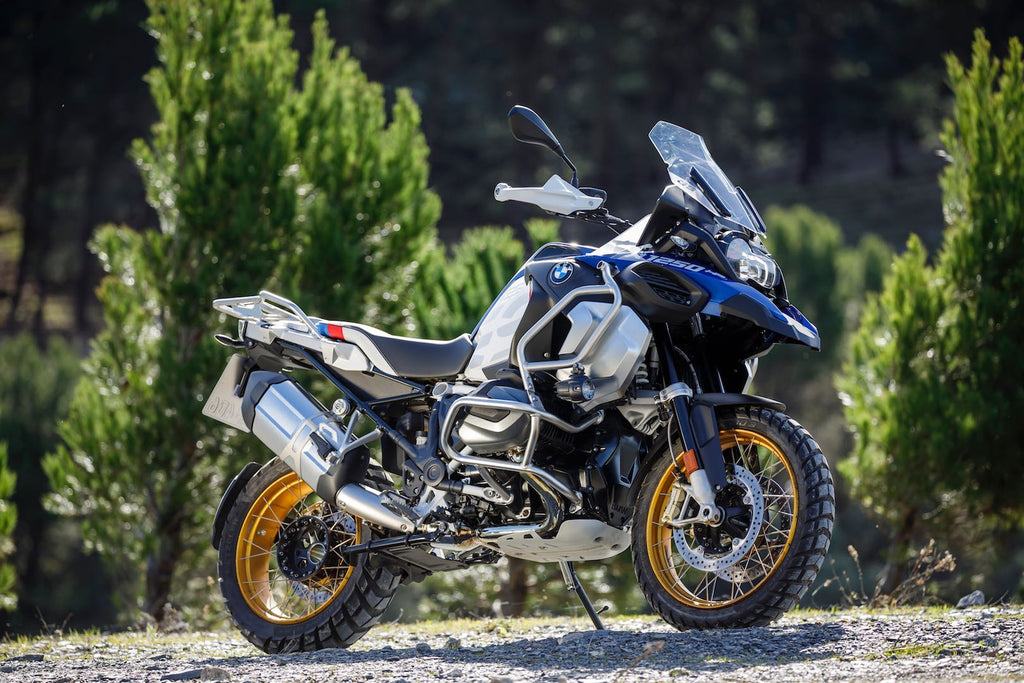BMW R 1250 GS vs R 1200 GS: What Changed for the Better?

Listen up ADV riders, there’s a new bike in (or out of) town—the BMW R 1250 GS and BMW R 1250 GS Adventure.
OK, we get it; the outgoing R 1200 GS encompassed serious potential and would tackle just about everything thrown in its way. So sure, you can keep on riding your old companion with no serious issue.
But BMW Motorrad strives for absolute adventuring touring perfection. With that idea in mind, BMW relaunched the 2019 model year with everything need to push the boundaries of adventuring, and nothing it doesn’t. It’s got more pep, state-of-the-art rider aid technology, and improved comfort features to make your ride that much more enjoyable.
Great just got greater.

2020 BMW R 1250 GS in action
Below, we explore the upgrades of the R 1250 GS and R 1250 GS Adventure, pointing out key updates from the outgoing model. This is the upper echelon of ADV touring.
Previous GS owners beware: A few miles aboard the updated R 1250 GS or GS A can and will urge you to trade in your old steed for the latest and greatest. Cough…we did exactly that.
BMW Increases Displacement on the 2019 GS and Employs BMW ShiftCam Technology
The biggest news of the BMW R 1250 GS and GS Adventure? The increased displacement of the flat-twin engine and employment of BMW ShiftCam technology.
The additional displacement is a direct result of BMW revising the basic architecture of the engine’s cylinders. Motorrad increased the bore and stroke measurement to 102.5 X 76.0mm on the new layout, varying from the 101.0 X 73.0mm that dates back to the ’04 R 1200 GS.
Overall displacement increases by 84cc to 1254cc, even more than the R 1200 to R 1250 rebadge suggests.
- BMW revises engine architecture, increasing both bore and stroke to gain an additional 84cc
- 5 X 76.0mm bore and stroke measurement
- Larger 1254cc displacement
And what’s the ShiftCam technology all about? It’s BMW Motorrad’s variable-valve-timing system with two sets of intake cam lobes—Partial Load and Full Load—that are both utilized depending on engine rpm and load.
But why a variable-valve-timing system on a big-displacement ADV motorcycle? It’s simple: These types of motorcycles need the best of all worlds. The top-end power demanded to propel a near 600-pound motorcycle at highway speeds requires later intake valve closing and more valve overlap under high loads.
On the other hand, creating a controllable initial throttle response and midrange torque that’s friendly on the varying surfaces that an ADV bike will cross requires the intake valves to open near top center and close near bottom center.
- BMW ShiftCam uses two intake cam lobes to broaden and increase power output
Float like a butterfly, sting like a bee!

BMW R 1200 GS - still amazing, but not as good as the R 1250 GS
More POWER – The Result of Engine Improvements
Bigger displacement and the inclusion of the BMW ShiftCam technology means increased and optimized power out for 2019 R 1250 GS.
BMW Motorrad claims that the new GS produces 136 horsepower at 7750 rpm, while producing a peak 105 pound-feet of torque at 6250 rpm. In comparison, that’s an 11 horsepower and 13 pound-feet of torque increase over the outgoing R 1200.
Where the power is produced, however, is the important factor. In simple terms, the R 1250 is roughly five to ten percent more powerful than the R 1200 in the entire rev range.
Example? From 6,250 to 9,000 rpm, the 1250 engine produces more horsepower than the 1200 did at its peak. Likewise, the 1250 produces at least 92 pound-feet of torque between 4,000 7,500 rpm, where the 1200 only hit that at a peak of 6,500 rpm.
Added bonus: Estimated fuel consumption is improved by six percent on the BMW R 1250 GS.
- Increased and optimized power and torque figures in comparison to the R1200
- Claimed 136 horsepower @ 7750 rpm
- Claimed 105 pound-feet @ 6250 rpm
- Improved fuel consumption
The new engine shines on top and continues pulling to its 9,000 rpm, meaning plenty of passing power for the open roads and speed to rip from one corner to the next.
On the low end, however, is where the ShiftCam proves its worth. Navigating through rocky, technical terrain, the power delivery of the R 1250 GS is exceptionally smooth and controllable. Consider the GS a tractor at slow speeds, with the capability of ripping impromptu third-gear wheelies on the highway.
2019: The Year of the Electronic Suite
What a time to be an ADV rider! BMW Motorrad has equipped the BMW R 1250 GS with a full suite of electronic rider aids—many of which taken from its endeavors in the open-class sportbike market—aimed at improving safety, comfort and efficiency during the long haul, without taking away from the emotion-evoking personality of the legendary ADV platform.
Fully equipped, the BMW R 1250 GS is almost infinitely tunable to rider preference. The additional $3500 Premium Package opens the doors to full adjustability of the motorcycle’s Pro Riding Modes, throttle response settings, including Dynamic Traction Control levels, ABS Pro settings, and Dynamic Brake Control (a whiskey throttle safety net!).
The Premium package also comes equipped with a semi-active Next-Gen Electronic Suspension Adjustment and Gear Shift Assist Pro (bi-directional quickshifter), as well as heated grips, cruise control, a tire pressure monitor, keyless ride and much more.
- Adjustable Pro Riding Modes
- Dynamic Traction Control
- ABS Pro
- Dynamic Brake Control
- Cruise Control
- Heated Grips
- Tire Pressure Monitor
Of course, each of the adjustable rider aids is tuned through a very large and easily readable 6.5 inch TFT color dashboard, which features a large tachometer, gear-position reading, and more.

The R 1250 GS is a thing of pure ADV beauty
The Biggest and Baddest GS to Date
With the 2019 R 1250 GS, BMW has created the most powerful and technologically advanced ADV touring platform to date.
The larger displacement GS sees significant improvements to its powerplant, including BMW ShiftCam technology which works to optimize and improve power output across the rev range.
The 1250 also receives a list of additional rider aids to help conquer that next route and be a little more comfortable in the process.
Believe us when we say the beloved GS hasn’t lost its character, only gained improvements that will keep it on top of the ADV market for years to come.
2019 BMW R 1250 GS Specs
Engine
- Displacement: 1254cc
- Type: air/ liquid-cooled, DOHC flat twin. w/ BMW ShiftCam technology
- Bore X Stroke: 102.5 X 76.0mm
- Compression ratio: 12.5:1
- Transmission: 6-speed
- Final Drive: Shaft drive
- Fueling: Electronic fuel injection w/ ride-by-wire
- Claimed power output: 136 horsepower @ 7750 rpm
- Claimed torque output: 105 pound-feet @ 6250 rpm
Chassis/Capacities
- Frame: Continuous tubular steel bridge-type
- Front suspension: BMW Telelever 37mm fork w/ central spring strut; 8.3 inches travel
- Rear suspension: BMW EVO Paralever and WAD strut w/ spring-preload and rebound-damping adjustable shock; 8.7 inches
- Front wheel: 3.00 x 19; wire cross-spoke
- Rear wheel: 4.50 x 17; wire cross-spoke
- Front tire: 120/70 x 19
- Rear tire: 170/60 x 17
- Front brakes: Dual floating 305mm discs w/ 4-piston fixed calipers
- Rear brake: 276mm disc, with dual-piston floating caliper
- Curb weight: 591 lb.
- Fuel capacity: 7.9 lb.

